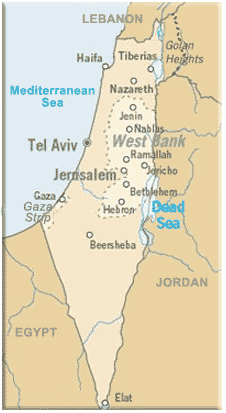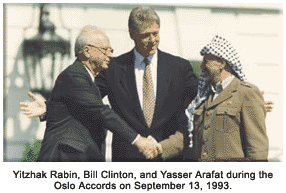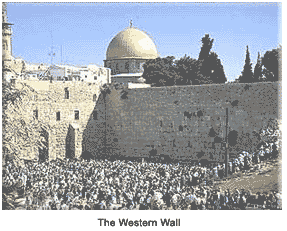 The principles of the plan, Road Map For Peace, were first outlined by U.S. president George W. Bush in a speech on June 24, 2002, in which he called for an independent Palestinian state living in peace with the Israeli state. Bush was the first U.S. President to explicitly call for such a Palestinian state.
Conflict between the Semitic nations, (Hebrew and Arabic), has remained a constant for the better part of 3,300 years, but more so since the creation of the State of Israel in 1948 following the Arab-Israeli War.
Balfour Declaration
The Balfour Declaration was a letter from the government of His Britannic Majesty King George the Fifth, dated November 2, 1917, to an international financier of the banking house of Rothschild, who had been made a peer of the realm. Lord Lionel Rothschild had been underwriting Jewish repatriation to Palestine.
Arthur Koestler wrote in the letter that "one nation solemnly promised to a second nation the country of a third." More than that, the country was still part of the empire of a fourth, namely Turkey.
Edmond de Rothschild (1845-1934), of the French Rothschilds, also was involved in responding to the threats facing the Jewish people in Europe in the late 19th century, by supporting massive land purchases and underwriting Jewish settlement in Palestine.
Brief post-World War I background
The principles of the plan, Road Map For Peace, were first outlined by U.S. president George W. Bush in a speech on June 24, 2002, in which he called for an independent Palestinian state living in peace with the Israeli state. Bush was the first U.S. President to explicitly call for such a Palestinian state.
Conflict between the Semitic nations, (Hebrew and Arabic), has remained a constant for the better part of 3,300 years, but more so since the creation of the State of Israel in 1948 following the Arab-Israeli War.
Balfour Declaration
The Balfour Declaration was a letter from the government of His Britannic Majesty King George the Fifth, dated November 2, 1917, to an international financier of the banking house of Rothschild, who had been made a peer of the realm. Lord Lionel Rothschild had been underwriting Jewish repatriation to Palestine.
Arthur Koestler wrote in the letter that "one nation solemnly promised to a second nation the country of a third." More than that, the country was still part of the empire of a fourth, namely Turkey.
Edmond de Rothschild (1845-1934), of the French Rothschilds, also was involved in responding to the threats facing the Jewish people in Europe in the late 19th century, by supporting massive land purchases and underwriting Jewish settlement in Palestine.
Brief post-World War I background
Following the war, in 1922, the lands south of present-day Turkey were given over to the French and British to administer as a temporary colonial "mandate." The area was divided between four areas, three of which remain today — Iraq, Lebanon, and Syria. The area between the Mediterranean Sea and the Jordan River was generally referred to as the "British Mandate of Palestine," or simply "Palestine." Its ethnic blend of Arabs, Jews, and Christians were collectively called "Palestinians." It is important to note the ethnic/religious populations at the time: Muslims numbered nearly 600,000, Jews about 85,000, and Christians just over 70,000. Persecutions of Jews in other parts of the world, however, fueled a Zionist movement* to gather scattered Jews into a new homeland in Palestine. That brought predictably hostile reactions from local Arabs.
Riots and attacks on new Jewish settlers sprang up in isolated areas on a regular basis, and during the "Great Uprising" from 1936 to 1939, British targets were fair game, as well.
Then in 1939, the British published its White Paper, which put a stranglehold on Jewish immigration. That brought predictably hostile reactions from local Jews.
Those skirmishes also led to the formation of Haganah, a Jewish underground militia. The fighting also confirmed the idea that reconciliation would be impossible, and that the idea of "partition" should be explored.
With the approach of World War II in Europe, the curtailment of Jewish immigration dissolved into the realm of theory.
By 1947, U.S. President Harry S. Truman had the Palestinian Partion Resolution ramrodded through the UN General Assembly. That brought predictably hostile actions from local Arabs and Jews — at least some segments of the Jewish community.
A pattern of utter frustration festered, in that any decision that was taken made one faction happy, the other, angry.
Bombings, raids, and sniping intensified. Casualties in the hundreds were now in the thousands. Arabs began to target roads and transportation arteries between Tel Aviv and Jerusalem, attacking Jewish civilian bus convoys. Haganah forces attacked Arab villages. A death on one side had to be met with revenge and deal death to the other.
The Arab-Israeli War
The Israelis called it their "War of Independence," the Arabs, "the Catastrophe."
Israel had made its stand and declared itself an independent state on May 14, 1948. It was quickly recognized diplomatically by the United States, the Soviet Union, and others.
By early 1949, Israel had signed peace treaties with all of its common-border neighbors.
With that broad historical brush stroke as a context, an Israeli-Palestinian conflict has been an on-again, off-again since the Six-Day War in 1967, when issues centering on the Gaza Strip, West Bank, and East Jerusalem arose.
The Six-Day War
The most significant of the Arab-Israeli conflicts was the Six-Day War in June 1967. In one fell swoop, the Israelis captured all of what was considered to be traditional or historic Palestine, including the Golan Heights from Syria in the north, the Sinai and Gaza Strip from Egypt in the south, the West Bank and all of Jerusalem from Jordan in the east. But there also was the issue of one million Palestinian Arabs who lived in the captured territory, and many Palestinian refugees who ended up in squalid camps in other countries.
Among the repercussions of the war was the crystalization of the Palestine Liberation Organization, created in 1964 and led by Yasser Arafat. That group would prove to be a major thorn in Israel's side.
The next military engagement was a "Mexican Standoff" known as the "War of Attrition" along the Suez Canal, during which the Israelis occupied the east bank. The tenor of that conflict consisted of trading an Israeli soldier's death for that of an Egyptian soldier. That fighting lasted about 18 months, from February 1969 to August 1970.
Then it was on to the Yom Kippur War of October 1973, when Egypt and Syria launched a surprise attack against Israel on one of the most holy of Jewish holy days. Four days later, Israel mounted an all-out counterattack to repel the insurgents.
 The Road Map
The Road Map
Overtures for peace have come and gone. One was a notable diplomatic success: Egypt recovered the Sinai Desert and Israel won free rein in the Occupied Territories, as results of the 1978 Camp David Accords brokered by President Jimmy Carter. Most, however were not successful.
Palestinians stepped up their insurrectionist behavior between 1987 and 1993 when U.S. President Bill Clinton helped to negotiate a peace settlement called the Oslo Accords, which were based on earlier work called the Madrid Framework. The Italian cruise ship Achille Lauro was hijacked on October 7, 1985, by four Palestinian terrorists who demanded the release of 50 Palestinian prisoners from Israel. They shot wheelchair passenger Leon Klinghoffer as a demonstration of their determination.
Another summit was called by President Clinton when he summoned Arafat and Israeli Prime Minister Ehud Barak to Camp David in July 2000. After two weeks, negotiations collapsed when neither side would offer enough to the other.
Of particular concern was the control over Jerusalem and the Temple Mount. Israel offered East Jerusalem and "custodianship" of the Temple Mount, a holy shrine. The Palestinians wanted "sovereignty" over the Mount, but that would have meant the Jews losing control over holy ground, which includes the Western Wall, a hallowed place of worship.
Soon after the summit, Israel's Ariel Sharon and others blatantly strolled around the Temple Mount to emphasize Israel's control over the area. The next day, Palestinians demonstrated against Sharon's arrogance. The crowd grew out of control and drew fire from the police.
That event was the catalyst for an Arab uprising called al-Aqsa Intifada, which means "uprising" or "shaking off," in Arabic. In laymen's terms, it is a war of national liberation against foreign occupation for the Palestinians, whereas Israelis consider it to be baldfaced terrorism inflicted on Jewish civilians.
It is against that bloody backdrop that the so-called Road Map for Peace was proffered by the "Quartet," a group of diplomats from the United Nations, European Union, Russia, and the United States.
The plan would be implemented in three phases:
 Under Phase I, violence on both sides is to stop; Israeli leadership agrees to a two-state region, acknowledging Palestine as independent, viable, and sovereign; institution building includes drafting a constitution for Palestinian statehood and to conduct free elections; Israel is to withdraw to pre-September 2000 territory, ceding the Gaza Strip and the West Bank to Palestine.
Under Phase I, violence on both sides is to stop; Israeli leadership agrees to a two-state region, acknowledging Palestine as independent, viable, and sovereign; institution building includes drafting a constitution for Palestinian statehood and to conduct free elections; Israel is to withdraw to pre-September 2000 territory, ceding the Gaza Strip and the West Bank to Palestine.
Phase II expects the new state of Palestine to crack down on terror and to practice democracy based on tolerance and liberty.
Phase III sees reform and peace negotiations to reach permanent agreement status. The Quartet finishes business with regard to border resolutions, Jerusalem, refugees, and settlements, as well as support peace agreements between Israel and Lebanon and Syria.